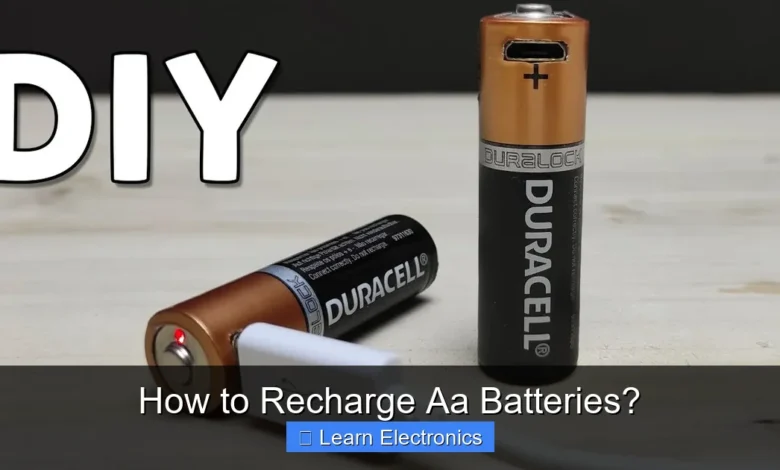How to Recharge Aa Batteries?

How to Recharge AA Batteries? It’s a common question with a straightforward answer: by using a compatible charger specifically designed for rechargeable nickel-metal hydride (NiMH) or nickel-cadmium (NiCd) cells. This process allows you to reuse batteries multiple times, significantly reducing waste and saving money. Understanding the correct approach is crucial for both safety and maximizing battery lifespan.
Quick Answers to Common Questions
Can I recharge any AA battery I have lying around?
Nope, not all AA batteries are created equal when it comes to recharging! You can only recharge AA batteries specifically designed for it, usually labeled as Nickel-Metal Hydride (NiMH) or sometimes older Nickel-Cadmium (NiCd) types. Attempting to recharge regular alkaline batteries can be risky.
What do I actually need to start recharging my AA batteries?
To safely recharge AA batteries, you’ll need two main things: a dedicated battery charger specifically designed for NiMH/NiCd batteries and, of course, the rechargeable AA batteries themselves. Always make sure your charger is compatible with the battery chemistry you’re using!
How long does it usually take to recharge AA batteries?
The time it takes to recharge AA batteries varies quite a bit depending on their capacity and the speed of your charger. Generally, you can expect anywhere from a few hours with a fast charger to overnight with a standard model; your charger should have an indicator to let you know when they’re ready.
📑 Table of Contents
Understanding Rechargeable AA Batteries
Before diving into the process, it’s vital to understand the fundamental difference between types of AA batteries. Not all AA batteries are designed for recharging, and attempting to recharge the wrong type can be dangerous.
Alkaline vs. NiMH/NiCd: The Fundamental Difference
The vast majority of AA batteries found in stores are alkaline, which are primary (single-use) cells. These are not meant to be recharged. Rechargeable AA batteries, on the other hand, are typically nickel-metal hydride (NiMH) or, less commonly now, nickel-cadmium (NiCd). These secondary (rechargeable) cells are engineered to undergo multiple charge and discharge cycles.
- Alkaline Batteries: These provide a high initial voltage but their voltage drops steadily during discharge. They are chemically designed for one-time use.
- NiMH Batteries: Offer a more stable voltage output throughout their discharge cycle and can be recharged hundreds of times. They are generally environmentally friendlier than NiCd batteries due to the absence of cadmium.
- NiCd Batteries: While rechargeable, NiCd batteries are less common now due to environmental concerns about cadmium and the “memory effect” they can exhibit.
The Risks of Attempting to Recharge Primary Cells
Attempting to recharge standard alkaline AA batteries is highly discouraged and dangerous. These batteries are not built to handle the chemical reactions involved in recharging. When you force a current through them, they can:
- Leak: The internal pressure builds up, causing the battery casing to rupture and corrosive electrolyte to leak out, damaging devices and posing a chemical hazard.
- Overheat: Excessive heat can be generated, potentially leading to burns or fire.
- Explode: In extreme cases, the internal pressure can lead to an explosion, scattering hazardous materials and battery components.
Always verify that your AA batteries are explicitly labeled “Rechargeable” or “NiMH” before placing them in a charger.
Choosing the Right Charger
The success and safety of recharging AA batteries largely depend on the charger you use. A good charger will not only recharge your batteries efficiently but also protect them from damage and extend their life.
Basic vs. Smart Chargers
There are generally two types of chargers available:
- Basic (Timed) Chargers: These chargers apply a constant current for a fixed period, regardless of the battery’s charge level. While simple and inexpensive, they risk overcharging if batteries are not fully depleted or are left in too long, which can shorten battery lifespan.
- Smart Chargers: Also known as intelligent or microprocessor-controlled chargers, these are highly recommended. They monitor each battery individually, detecting its voltage, temperature, and charge status. Smart chargers typically use technologies like negative delta V (ΔV) cut-off to determine when a battery is fully charged, preventing overcharging. Many also have trickle charge capabilities to maintain full charge without damage and safety features like bad battery detection.
Charger Features for Optimal Battery Life
When selecting a charger, look for these features to ensure optimal performance and longevity for your rechargeable AA batteries:
- Individual Charging Slots: Allows each battery to be charged independently based on its specific needs, preventing under- or overcharging of individual cells.
- Negative Delta V (ΔV) Cut-off: A key feature of smart chargers, it detects a slight voltage drop when a battery is full, signaling the charger to stop or switch to a trickle charge.
- Temperature Monitoring: Prevents overheating, a common cause of battery degradation.
- Discharge Function: Some chargers include a discharge mode that fully drains batteries before recharging, which can sometimes help condition older NiCd cells, though it’s generally unnecessary for modern NiMH batteries.
- Bad Battery Detection: Identifies non-rechargeable or damaged batteries, preventing them from being charged and potentially causing issues.
- Trickle Charge: Once fully charged, the charger supplies a very low current to maintain the battery’s charge without overcharging, keeping them ready for use.
The Essential Guide to How to Recharge AA Batteries
Once you have the correct type of rechargeable AA batteries and a suitable charger, the process is straightforward. Following these steps will ensure safe and effective recharging.
Preparing Your Batteries
Before placing batteries in the charger, inspect them for any signs of damage, such as leaks, bulges, or corrosion. Do not attempt to charge damaged batteries. For optimal results, ensure your batteries are at room temperature. If they’ve been used recently, allow them to cool down before charging.
Inserting Batteries into the Charger
Carefully insert each rechargeable AA battery into its designated slot in the charger, ensuring the polarity (+ and – ends) matches the markings on the charger. Most chargers have clear indicators for correct placement. If using a smart charger with individual slots, you can charge one, two, or more batteries as needed.
Monitoring the Charging Cycle
Once the batteries are correctly inserted, plug in the charger. Most chargers have indicator lights that show the charging status (e.g., red for charging, green for fully charged). Smart chargers may have more sophisticated displays indicating charge level or estimated time remaining. Do not leave charging batteries unattended, especially with basic chargers. While modern smart chargers are designed to prevent overcharging, it’s good practice to disconnect batteries once they are full.
Removing and Storing Fully Charged Cells
Once the indicator lights signal that the batteries are fully charged, unplug the charger and carefully remove the batteries. They might feel slightly warm, which is normal. Store the fully charged batteries in a cool, dry place, ideally in a battery case to prevent accidental short circuits or contact with metal objects. Avoid storing them in extreme temperatures.
Optimizing Battery Life and Performance
Proper care goes a long way in extending the life and maintaining the performance of your rechargeable AA batteries. This practice ensures you get the most out of your investment.
Avoiding Overcharging and Over-discharging
Overcharging, as mentioned, can reduce battery lifespan by causing internal stress and heat. Always use a smart charger to prevent this. Similarly, allowing NiMH batteries to discharge completely too often can also be detrimental. While NiMH batteries are less prone to the “memory effect” than older NiCd types, extremely deep discharges can slightly reduce their capacity over time. It’s generally best to recharge them when they are partially depleted rather than waiting until they’re completely dead, especially for high-drain devices.
Proper Storage Techniques
When not in use, store your rechargeable AA batteries in a cool, dry place away from direct sunlight and extreme temperatures. High temperatures can accelerate self-discharge and degrade battery chemistry. Ideally, store them at around 50% charge if they will be unused for an extended period (several months). Avoid storing them fully discharged or fully charged for very long durations.
Understanding Battery Memory Effect (and why it’s less common now)
The “memory effect” was a significant concern with older NiCd batteries. It meant that if batteries were repeatedly recharged before being fully discharged, they would “remember” the point at which recharging began and then only deliver power up to that point in subsequent uses. Modern NiMH batteries are largely immune to this effect. Therefore, it’s not necessary to fully discharge NiMH batteries before recharging them; in fact, doing so repeatedly can shorten their overall lifespan.
Troubleshooting Tips: How to Recharge AA Batteries When Problems Arise
Even with the best practices, you might occasionally encounter issues when attempting to recharge AA batteries. Here are some common problems and their solutions.
Battery Not Charging
If a battery isn’t charging, consider the following:
- Check Polarity: Ensure the battery is inserted correctly with positive and negative terminals aligned.
- Charger Compatibility: Verify that the charger is designed for NiMH/NiCd batteries and is functional (try charging a known good battery).
- Battery Condition: The battery might be too old, deeply discharged (some chargers have trouble “waking up” deeply discharged cells), or simply dead. Try a different battery.
- Corrosion: Check battery terminals and charger contacts for corrosion. Clean them gently with a pencil eraser or cotton swab dipped in rubbing alcohol.
Reduced Capacity After Recharging
If your batteries seem to hold less charge over time or don’t last as long, it could be due to:
- Age: All rechargeable batteries have a finite lifespan, typically 500-1000 charge cycles. As they age, their capacity naturally diminishes.
- Overheating: Frequent overheating during charging or discharge can permanently reduce capacity.
- Deep Discharge: While NiMH batteries are less prone to memory effect, extremely deep discharges, especially repeated ones, can sometimes impact capacity.
- Charger Issues: A faulty charger might not be fully charging the batteries.
Heat During Charging
It’s normal for batteries to feel slightly warm during charging. However, excessive heat indicates a problem:
- Overcharging: A basic charger without proper cut-off can overcharge and overheat batteries.
- Faulty Battery: A damaged or internal shorted battery can generate excessive heat. Immediately remove very hot batteries from the charger.
- Charger Malfunction: The charger itself might be faulty.
- Environmental Factors: Charging in a very hot environment can also contribute to overheating.
AA Battery Specifications and Recharge Cycles
Understanding some basic specifications can help you make informed decisions about your rechargeable AA batteries.
Common AA Battery Types and Characteristics
The table below provides a quick overview of common AA battery types and their typical characteristics relevant to recharging.
| Battery Type | Nominal Voltage | Typical Capacity (mAh) | Recharge Cycles | Memory Effect | Primary Use Cases |
|---|---|---|---|---|---|
| Alkaline (Primary) | 1.5V | ~2000-3000 | 0 | N/A | Low-drain devices (remotes, clocks) |
| NiMH (Rechargeable) | 1.2V | ~1800-2700 | 500-1000 | Minimal | High-drain devices (cameras, toys, flashlights) |
| NiCd (Rechargeable) | 1.2V | ~600-1200 | 500-1000 | Significant | Older cordless tools (less common for AA) |
Note: Capacities are approximate and can vary by brand and specific model.
Rechargeable AA batteries are an excellent investment for anyone looking to power their devices efficiently and sustainably. By understanding the different battery types, choosing a smart charger, and following proper charging and care guidelines, you can significantly extend their lifespan and ensure reliable performance. Always prioritize safety, especially by never attempting to recharge single-use alkaline batteries. With the right knowledge and tools, you’ll master the art of recharging and enjoy the long-term benefits of these versatile power sources.
Frequently Asked Questions
Can all AA batteries be recharged?
No, not all AA batteries can be recharged. Only specific types, primarily Nickel-Metal Hydride (NiMH) and Nickel-Cadmium (NiCd), are designed for recharging. Attempting to recharge standard alkaline AA batteries is dangerous and can lead to leaks, overheating, or even explosions.
What type of charger should I use to recharge AA batteries?
You should use a charger specifically designed for rechargeable AA batteries, typically compatible with NiMH and/or NiCd chemistries. A smart charger is recommended as it monitors individual battery status, prevents overcharging, and can extend the lifespan of your AA batteries.
How long does it typically take to recharge AA batteries?
The time it takes to recharge AA batteries varies significantly depending on their capacity (measured in mAh) and the speed of your charger. A fast charger might recharge batteries in 2-4 hours, while a slower charger could take 8-16 hours. Always refer to your charger’s instructions for estimated charging times.
How do I know when my AA batteries are fully recharged?
Most modern battery chargers have indicators, such as LED lights, that signal when your AA batteries are fully charged. Many smart chargers also feature an auto-shutoff function to prevent overcharging once the batteries reach their full capacity. Consult your specific charger’s manual to understand its indicators.
What are some safety tips for recharging AA batteries?
Always ensure you are only attempting to recharge AA batteries explicitly labeled as “rechargeable” using the correct type of charger. Never try to charge alkaline or carbon-zinc batteries, and avoid mixing different battery types or brands within the same charging cycle. Store batteries and chargers in a cool, dry place away from flammable materials.



